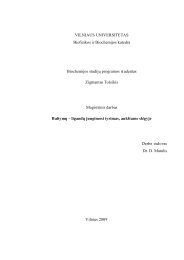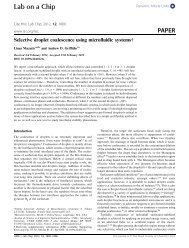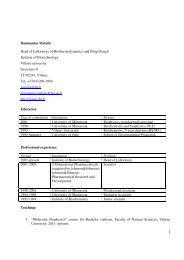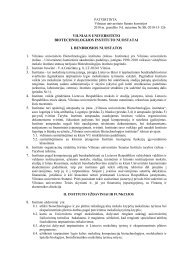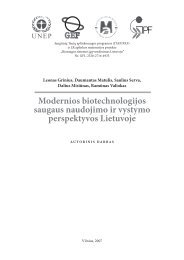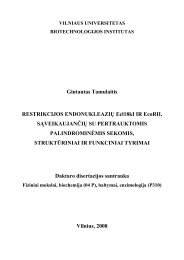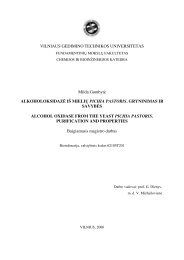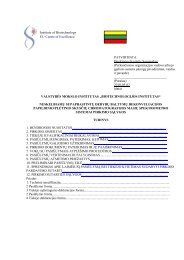Determination of the thermodynamics of carbonic anhydrase acid ...
Determination of the thermodynamics of carbonic anhydrase acid ...
Determination of the thermodynamics of carbonic anhydrase acid ...
You also want an ePaper? Increase the reach of your titles
YUMPU automatically turns print PDFs into web optimized ePapers that Google loves.
1046 L. Baranauskienė et al. / J. Biochem. Biophys. Methods 70 (2008) 1043–1047<br />
The enthalpy dependence on temperature was calculated by:<br />
D u H ¼ D u H Tm þ D u C pTm þ DD u C p ðT<br />
T m Þ ðT T m Þ ð2Þ<br />
where Δ u H Tm is <strong>the</strong> enthalpy <strong>of</strong> unfolding at melting temperature.<br />
It was determined by regression <strong>of</strong> <strong>the</strong> experimental<br />
data (Fig. 5). The best fit yielded Δ u H Tm = 803 kJ/mol.<br />
O<strong>the</strong>r <strong>the</strong>rmodynamic parameters could also be estimated<br />
using <strong>the</strong> same value <strong>of</strong> ΔΔ u C p . The entropy <strong>of</strong> unfolding was<br />
calculated by:<br />
D u S ¼ D u S Tm þ D u C pTm þ DD u C p ðT<br />
T m Þ <br />
ln T <br />
ð3Þ<br />
T m<br />
where Δ u S Tm is <strong>the</strong> entropy <strong>of</strong> unfolding at <strong>the</strong> melting<br />
temperature obtained by:<br />
D u S Tm ¼ D uH<br />
ð4Þ<br />
T m<br />
since <strong>the</strong> Gibbs free energy <strong>of</strong> unfolding at T m is equal to zero:<br />
D u G Tm ¼ 0 ð5Þ<br />
The Gibbs free energy was computed at various temperatures<br />
by:<br />
D u G ¼ D u H TD u S ð6Þ<br />
The probability <strong>of</strong> <strong>the</strong> protein to remain folded at various<br />
temperatures was calculated by:<br />
1<br />
P folded ¼<br />
ð7Þ<br />
1 þ e D uG=RT<br />
The probability multiplied by <strong>the</strong> enthalpy <strong>of</strong> unfolding gives<br />
<strong>the</strong> enthalpy that could be observed by ITC and predicts <strong>the</strong><br />
steep drop <strong>of</strong> <strong>the</strong> <strong>acid</strong>-ITC enthalpy (bold line in Fig. 5):<br />
D u H max ITC ¼ D u H P folded ð8Þ<br />
This maximum <strong>of</strong> <strong>the</strong> enthalpy <strong>of</strong> unfolding that could be<br />
observed by ITC was estimated to be 691 kJ/mol at 60 °C.<br />
4. Discussion<br />
It is common practice to determine <strong>the</strong> enthalpy <strong>of</strong> protein<br />
unfolding by differential scanning calorimetry (DSC). This<br />
approach limits <strong>the</strong> available data to higher temperatures where<br />
most proteins denature, ranging from about 50 to 70 °C.<br />
Proteins have to be artificially destabilized to reduce <strong>the</strong>ir<br />
melting temperature. One <strong>of</strong> <strong>the</strong> most common means to<br />
destabilize a protein is to reduce <strong>the</strong> pH. It was shown using<br />
lysozyme as a model protein that <strong>the</strong> enthalpy <strong>of</strong> unfolding<br />
determined by DSC at various pHs is equal to <strong>the</strong> enthalpy <strong>of</strong><br />
unfolding determined by iso<strong>the</strong>rmal calorimetric titration <strong>of</strong> <strong>the</strong><br />
protein with <strong>acid</strong> [9].<br />
Here we use <strong>the</strong> same approach to determine <strong>the</strong> enthalpy <strong>of</strong><br />
<strong>carbonic</strong> <strong>anhydrase</strong> unfolding by iso<strong>the</strong>rmal titration calorimetry<br />
(ITC), by carrying out denaturation with <strong>acid</strong> and comparing<br />
<strong>the</strong> observed enthalpy (Δ u H ITC ) with <strong>the</strong> enthalpy obtained by<br />
DSC (Δ u H DSC ) in our earlier study [10]. Such an approach<br />
significantly expands <strong>the</strong> accessible temperature range (down<br />
to nearly 0 °C) and measures enthalpies at constant temperature.<br />
Fur<strong>the</strong>rmore, it provides more detailed information about<br />
<strong>the</strong> T-dependence <strong>of</strong> <strong>the</strong> heat capacity <strong>of</strong> unfolding.<br />
During any <strong>acid</strong> titration one observes <strong>the</strong> sum <strong>of</strong> processes<br />
such as dilution <strong>of</strong> <strong>the</strong> <strong>acid</strong>, dilution <strong>of</strong> <strong>the</strong> protein solution,<br />
protonation <strong>of</strong> <strong>the</strong> ionic groups <strong>of</strong> <strong>the</strong> protein (aspartic <strong>acid</strong>,<br />
glutamic <strong>acid</strong>, and histidine residues), aggregation <strong>of</strong> <strong>the</strong><br />
protein, and anion binding to <strong>the</strong> positively charged protein at<br />
low pH. Analysis <strong>of</strong> <strong>the</strong> data may be fur<strong>the</strong>r complicated if <strong>the</strong><br />
unfolding reaction is not fully reversible, or if unfolding intermediates<br />
are present, such as <strong>the</strong> molten globule that was<br />
reported for <strong>carbonic</strong> <strong>anhydrase</strong> [13]. Our previous DSC<br />
analysis at low pH indicated that <strong>the</strong> process is reversible and<br />
could be described by a simple two-state model at any tested pH<br />
[10]. While <strong>the</strong> possible contributions <strong>of</strong> anion binding and<br />
molten globule formation to <strong>the</strong> unfolding energetics were not<br />
determined in this study, it is remarkable that DSC and ITC<br />
approaches yielded essentially <strong>the</strong> same enthalpy <strong>of</strong> unfolding<br />
at about 40 °C, which is a strong indication that <strong>the</strong> enthalpies<br />
obtained by both methods are accurate and consistent.<br />
The concave-up curvature <strong>of</strong> Δ u H versus temperature shown<br />
in Fig. 5 indicates that <strong>the</strong> heat capacity <strong>of</strong> unfolding is becoming<br />
more positive as <strong>the</strong> temperature increases. From <strong>the</strong> curvature <strong>of</strong><br />
<strong>the</strong> Δ u H dependence on temperature (Fig. 5) we have determined<br />
<strong>the</strong> second derivative to be about ΔΔ u C p =100±30J/(mol×K 2 ).<br />
This is inconsistent with <strong>the</strong> previous calculations and observations<br />
reviewed by [1] since <strong>the</strong>ir results indicated that Δ u C p<br />
decreases as <strong>the</strong> temperature increases. Biophysical community is<br />
in general agreement that <strong>the</strong> ΔΔ u C p <strong>of</strong> protein unfolding should<br />
be negative.<br />
However, our value may be explainable by <strong>the</strong> behaviour <strong>of</strong><br />
alkanes in water by comparing <strong>the</strong> reaction <strong>of</strong> protein refolding<br />
with <strong>the</strong> reaction <strong>of</strong> alkane aggregation in water. The heat capacity<br />
change <strong>of</strong> linear alkane aggregation expressed per mole <strong>of</strong><br />
methylene group (CH 2 ) per degree is equal to −0.24 J/(mol<br />
CH 2 ×K 2 ) [14,15]. TheT-derivative <strong>of</strong> <strong>the</strong> heat capacity <strong>of</strong> <strong>carbonic</strong><br />
<strong>anhydrase</strong> unfolding was measured here to be 100 J/(mol<br />
CH 2 ×K 2 ), thus for <strong>the</strong> process <strong>of</strong> refolding <strong>the</strong> value is −100 J/<br />
(mol CH 2 ×K 2 ). Dividing this value for <strong>the</strong> entire protein by <strong>the</strong><br />
value for <strong>the</strong> methylene group, we obtain that <strong>the</strong>re could be about<br />
420 methylene groups that are hidden from water during <strong>the</strong><br />
folding reaction.<br />
From <strong>the</strong> bCAII amino <strong>acid</strong> sequence and structure, we<br />
calculate that <strong>the</strong>re are 530 methylene, methyl, and aromatic<br />
carbon atoms in <strong>the</strong> side chains <strong>of</strong> amino <strong>acid</strong>s that are hidden<br />
inside <strong>the</strong> folded protein molecule and representing <strong>the</strong> maximum<br />
number <strong>of</strong> small hydrophobic groups that may become exposed to<br />
water if complete unfolding <strong>of</strong> <strong>the</strong> protein occurred.<br />
The number estimated from <strong>the</strong> energetic measurements,<br />
420, is similar to <strong>the</strong> number <strong>of</strong> hydrophobic groups calculated<br />
from <strong>the</strong> protein sequence and structure, 530. This could be just<br />
a fortuitous coincidence or it may have a physical basis. The<br />
difference (~20%) could be accounted for by <strong>the</strong> fact that not all<br />
hydrophobic groups are fully exposed to water upon unfolding.<br />
Fur<strong>the</strong>rmore, <strong>the</strong> aromatic and aliphatic groups are probably




